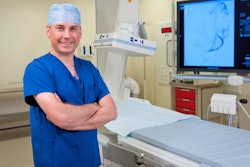Adding dynamic CT perfusion (DynCTP) to cardiac CT angiography (CCTA) shortens time to diagnosis of coronary artery disease (CAD), according to research presented at the Society of Cardiovascular Computed Tomography (SCCT) meeting in Washington, DC.
A team led by David Vilades Medel, PhD, of Hospital de la Santa Creu i Sant Pau in Barcelona, Spain, found that the combination cut time to diagnosis by 42% and decreased the need for further functional tests by 48%.
"In our center, implementing a CCTA plus DynCTP diagnostic algorithm in symptomatic patients with suspected CAD or known CCS [chronic coronary syndrome] significantly shortened the diagnostic process and number of additional tests," the group reported.
CCTA is a valuable tool for diagnosing symptomatic patients with suspected CAD or a history of CCS, the researchers noted. DynCTP illuminates the effect of coronary stenosis on blood flow and is used to detect myocardial ischemia, adding functional information to anatomical studies and "[integrating] the diagnostic process into a single noninvasive imaging technique," they wrote.
Medel's group investigated the clinical performance of a diagnostic algorithm based on CCTA plus DynCTP in symptomatic patients with suspected CAD or a history of CCS, comparing it with the CCTA-only algorithm. Their study included 204 patients divided into two cohorts: one that underwent a CCTA-only algorithm from January 2017 to January 2019 and a second that underwent a diagnostic algorithm based on CCTA plus DynCTP from April 2021 to May 2023 (DynCTP was performed if a patient's Coronary Artery Disease Reporting and Data System [CAD-RADS] score equal to or higher than 3 or inconclusive). The team matched study participants by gender, cardiovascular risk factors prevalence, and atherosclerotic burden as indicated by their CAD-RADS score, then noted the following:
- Functional tests (stress echo, stress cardiac magnetic resonance, or treadmill test)
- Cardiac catheterizations
- Major cardiovascular events such as cardiovascular mortality, acute coronary syndrome, and the need for revascularization
Overall, adding DynCTP improved the performance metrics of CCTA, Medel and colleagues reported.
| Performance comparison, CCTA-only and CCTA plus DynCTP protocols* | ||
|---|---|---|
| Measure | CCTA-only algorithm cohort | CCTA plus DynCTP cohort |
| Radiation dose | 676 mGy | 412 mGy |
| Contrast volume | 76 mL | 94 mL |
| Additional functional tests | 43% | 23% |
| Time to a clinical decision on therapeutic strategy | 102 days | 60 days |
| Number of requested cardiac catheterizations without prior functional information | 64% | 9% |
| *All results were statistically significant | ||
The team did not report significant differences between the groups in the number of cardiac catheterizations performed (cohort 1, 27% vs. cohort 2, 33%) or major cardiovascular events (cohort 1, 24% vs. cohort 2, 28%).
"In our center, implementing a CCTA plus DynCTP diagnostic algorithm in symptomatic patients with suspected CAD or known CCS significantly shortened the diagnostic process and number of additional tests," the investigators concluded. "This approach also increased the percentage of patients referred to invasive catheterization with prior functional information."




















